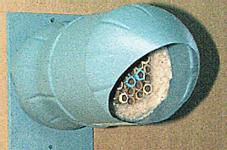Many native solitary bees are found throughout North America, and together with other bee species such as honeybees and bumblebees, they are important pollinators of fruit and vegetables.
When the daytime high temperature reaches 14 C (57°F), the Blue Orchard bee starts to emerge. The males emerge a few days before the females. They mate and then the female looks for places to lay her eggs. She prefers to lay her eggs in small holes, often in tree trunks or fences. When she has found a suitable nest, she collects many grains of pollen, mixes it with nectar, and lays an egg on the lump of pollen. Then she collects wet mud or other materials and makes a wall as protection from parasites and predators. After one cell is closed with mud, she sets out to collect pollen and nectar for another cell, and she continues until she runs out of eggs.
You can attract Blue Orchard Mason Bees into your garden by building your own “Condo” for them. It’s easy and can be made with recycled materials to boot.
Materials needed:
- 1 waxed milk carton or juice container, non-transparent
- Screws
- 15 Paper Straws
- 2 rubber bands
- Wood Glue
- Newspaper
- Foam (or any soft stuffing for insulation)
Prepare the Condo as follows:
Screw a one liter waxed milk or juice container to the outside of your garage, shed, or house wall, in a sheltered spot out of the wind. These nests should be placed in a sunny, southern or eastern location near your garden so that the bees can pollinate your fruit trees. The height is not that important, the bees seem to nest in straws anywhere from three to 20′ above ground, but put it at eye level so you can watch the bees in action
Cut the straws approximately in half (some slightly less than 6″ and some slightly more than 6″) and bundle the straws together with an elastic band. Note that the uneven length of nesting straws is a cue for bees to orient to their nest.

Cut five x 6″ squares of newspaper and glue them around the bundle for the first layer of insulation. Place another rubber band over the newspaper to keep it snug. Wrap the bundle with foam to insulate the bees from extreme cold and heat. Insert the bundle of straws and insulation, as one unit, into the waterproof container. If there is extra room around the straws, fill it with more foam.
Each female solitary bee will use about two and a half of the six-inch straws per season. To increase the chance of bees finding your homemade condo, you can decorate your nest with pale-colored paint. In addition, you could color the end of a few of the nesting straws to make active nesting straws easier to locate for returning bees.
Leave the nests outside all year in mild winter areas (Zones 7 and above). You could move them to a more sheltered spot out of the worst of the rain and snow and move them back to your ideal spot in mid-February. Each year, provide more empty straws for new nests.
Questions about Orchard Mason Bees and making condos can be sent to Derryat wchase@interchange.ubc.ca

